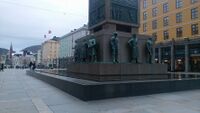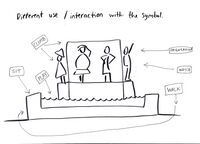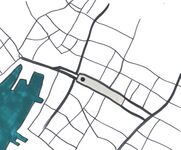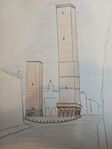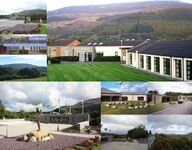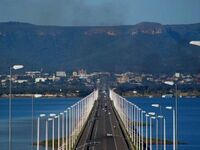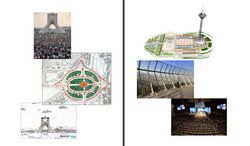LED Seminar 2016 - Landscape Symbols Reflection Group E
Landscape Symbol 1- Monument Bergen, Kjersti Børve Skjelbreid
Representations and analytical drawings
in addition to your initial visual please add two further analytical drawings of your symbol
Reflections
Please write a 250 words text reflecting on the following questions, you can also take ideas from your group members into account
- How and why did the symbols you identify appear in your landscape?
- Did their meaning change along with socio-political, economic, environmental or cultural changes in your region, or country?
- What do these symbols mean to you today? Are they meaningful to more than just one cultural group? Are they shared across cultures?
The symbol is human made, with high presicion and classical aesthetics. It's in the middle of a popular and busy square. It's very big, and attrackts lots of attention. It's made for decoration and usage - it's nice to look at, but people are also sitting on it.
The reason why I chose this symbol, is because I read an article about it, and this changed my view on items like this in a community. The article was about the square and different groups of people who used different parts of the square as meeting places. One group of elderly people used this monument as a meeting place almost every day of the year. Many of them had worked at sea, and identified strongly with the monument. At some point the area around it was closed off because of renovation, and the article described how these people where cut off from their daily social gathering, and how this effected their lives in a negative way, and how they struggled with suddenly having no place to meet old and new friends.
This story made me realize how important such monuments can be for identity, and for the social life. It's also a good place to hang out for everyone, not just those who directly identify with the theme of the monument (seafarers, etc.)
Landscape Symbol 2-Two towers Bologna, Davide Lombardi
Representations and analytical drawings
in addition to your initial visual please add two further analytical drawings of your symbol
- GroupI slide2.JPG
slide 2
- GroupI slide3.JPG
slide 3
Reflections
During the Middle Age was customary to build towers in Bologna as a demostration of power and wealth by the most important families. The two towers depicted belonged to two different families, who have given them the names which we know them. The hightest one is over 100 meters, in the historic center is the tallest building, there is indeed the rule that it's not possible to build anything higter in the area. Thanks to this feature the two towers lend themselves as the perfect point of reference.
Landscape Symbol 3-Ti Chulain centre in Ireland, Joseph Murphy
Representations and analytical drawings
in addition to your initial visual please add two further analytical drawings of your symbol
- GroupI slide2.JPG
slide 2
- GroupI slide3.JPG
slide 3
Reflections
Please write a 250 words text reflecting on the following questions, you can also take ideas from your group members into account
- How and why did the symbols you identify appear in your landscape?
- Did their meaning change along with socio-political, economic, environmental or cultural changes in your region, or country?
- What do these symbols mean to you today? Are they meaningful to more than just one cultural group? Are they shared across cultures?
add your text here
Landscape Symbol 4-Palmas Brazil, Gabriela Deveras
Representations and analytical drawings
in addition to your initial visual please add two further analytical drawings of your symbol
- GroupI slide2.JPG
slide 2
- GroupI slide3.JPG
slide 3
Reflections
Please write a 250 words text reflecting on the following questions, you can also take ideas from your group members into account
- How and why did the symbols you identify appear in your landscape?
- Did their meaning change along with socio-political, economic, environmental or cultural changes in your region, or country?
- What do these symbols mean to you today? Are they meaningful to more than just one cultural group? Are they shared across cultures?
add your text here
Landscape Symbol 5- The old and new symbols of Tehran, Sanaz Emmamverdi
Representations and analytical drawings
in addition to your initial visual please add two further analytical drawings of your symbol
- Slide-1.JPG
- GroupI slide3.JPG
slide 3
Reflections
Please write a 250 words text reflecting on the following questions, you can also take ideas from your group members into account
- How and why did the symbols you identify appear in your landscape?
- Did their meaning change along with socio-political, economic, environmental or cultural changes in your region, or country?
- What do these symbols mean to you today? Are they meaningful to more than just one cultural group? Are they shared across cultures?
Tehran has two old and new towers as symbols of the city. There has been always a contrast between these two towers to be accepted by people as the most outstanding symbol of the city. Azadi tower is a monument located at Azadi square, in Tehran. It is one of the symbols of Tehran and marks the west entrance of the city. In 1966, an Iranian architect won a competition of designing the Iranian landmark. this tower formerly known as the Shahyad tower("King Memorial Tower" in honor of the Shah). But after revolution, in 1979, the name was changed to Azadi("Freedom"). During revolution, many protests have been taken place around this tower. Recently, after the tenth presidential election in Iran, Azadi square was the gathering place for protesters against the election's result. Milad Tower also known as the Tehran tower is a multi-purpose tower in Tehran. It is the sixth tallest concrete tower in the world. the tower is part of a complex called International Trade and Convention center of Tehran. The tower was first proposed as part of the " Shahestan Pahlavi" project before revolution. After 1979 revolution the project was cancelled. In 2008, Milad tower with the aim of building a memorable structure as a symbol for the city of Tehran and to meet the needs of telecom and television has been built. These days, this tower attracts many local people and tourists who want to see the Tehran from a higher point and are interested in museums , concerts, shopping and other attractions around this tower. Based on recent questionnaire, it showed majority of the citizens have introduced the Azadi tower as a symbol of Tehran.
Group reflection
Please add a summary of your group reflection here
